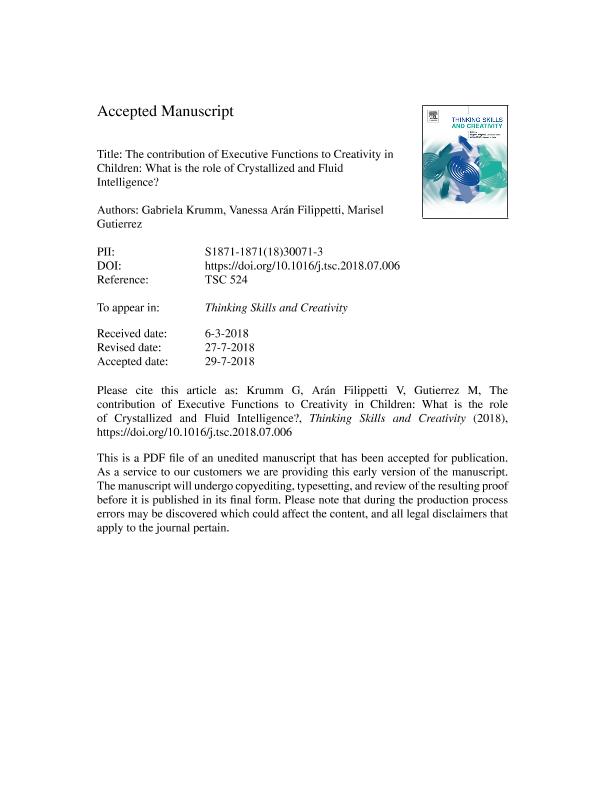Artículo
The contribution of executive functions to creativity in children: What is the role of crystallized and fluid intelligence?
Fecha de publicación:
09/2018
Editorial:
Elsevier
Revista:
Thinking Skills and Creativity
ISSN:
1871-1871
Idioma:
Inglés
Tipo de recurso:
Artículo publicado
Clasificación temática:
Resumen
Recent studies have revealed that intelligence and executive functions (EFs) play an important role in creative thinking. However, most research has focused on adult populations, without providing enough clarity as regards the way this complex relationship is manifested in children. The present study broadens and deepens the scope of previous research concerning children, analyzing the relationship between creativity, intelligence and EF, and examining the bond between the three constructs through an Structural Equation Modeling (SEM) approach. A total of 209 8- to 13-year-olds of both sexes (boys n = 86, girls n = 123) were administered measures of creativity, crystallized (Gc) and fluid intelligence (Gf) and EFs (i.e., working memory, inhibition and shifting). Correlational analyses revealed associations between all cognitive variables under study. After controlling for the child's level of intelligence, only shifting and inhibition continued to make a significant contribution to creativity. Moreover, SEM results indicated that the effect of Gc on creativity was mediated by shifting. These findings suggest that EFs differently support creativity in children and that shifting is a more powerful predictor of creativity than fluid and crystallized intelligence.
Palabras clave:
CHILDHOOD
,
CREATIVITY
,
EXECUTIVE FUNCTIONS
,
INTELLECTUAL ABILITIES
,
SEM
Archivos asociados
Licencia
Identificadores
Colecciones
Articulos(CIIPME)
Articulos de CENTRO INTER. DE INV. EN PSICOLOGIA MATEMATICA Y EXP. "DR. HORACIO J.A RIMOLDI"
Articulos de CENTRO INTER. DE INV. EN PSICOLOGIA MATEMATICA Y EXP. "DR. HORACIO J.A RIMOLDI"
Articulos(OCA SAAVEDRA 15)
Articulos de OFICINA DE COORDINACION ADMINISTRATIVA SAAVEDRA 15
Articulos de OFICINA DE COORDINACION ADMINISTRATIVA SAAVEDRA 15
Citación
Krumm, Gabriela Liliana; Arán Filippetti, Vanessa; Gutierrez Saez, Marisel Luisa; The contribution of executive functions to creativity in children: What is the role of crystallized and fluid intelligence?; Elsevier; Thinking Skills and Creativity; 29; 9-2018; 185-195
Compartir
Altmétricas




